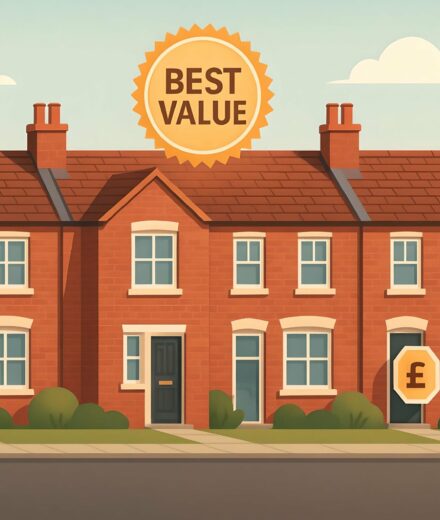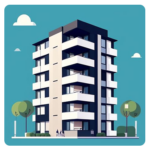

Review property performance across Stockton-on-tees since 2018, with breakdowns by home type, internal district, and external market.
You’ll also learn which parts of Stockton-on-tees are gaining attention – and how those trends compare externally.
House Prices > Stockton-on-tees
| Year | Average Price | Transactions |
|---|---|---|
| 2025 (proj.) | £179,100 | 2,778 |
| 2024 | £176,700 | 2,101 |
| 2023 | £184,000 | 2,535 |
| 2022 | £174,600 | 3,098 |
| 2021 | £168,500 | 3,441 |
| 2020 | £164,100 | 2,534 |
| 2019 | £161,500 | 3,003 |
| 2018 | £163,500 | 2,735 |
The Stockton-on-Tees property market has danced to its own slow, wistful waltz since 2018, with average prices never quite breaking into a runaway crescendo. Instead, the data whispers of a market that rises and falls with soft, unpredictable rhythm – not unlike the Tees in autumn, gentle but never entirely still.
It’s tempting to say Stockton-on-Tees remains an affordable bolthole, especially compared to overheated southern cities, but first-time buyers are still feeling the squeeze. Bidding wars on certain streets are fiercer than a last-minute scramble for a chippy after Boro’s home games. The dream of bagging a roomy terrace or semi at a comfortable price seems to be whispering away, year on year.
Looking for granular detail on the best streets and the true factors shaping prices locally? Discover Your Home’s True Worth in Stockton-On-Tees for the latest hyper-local breakdowns.
Despite all the ebb and flow, the town’s average property price has grown by more than 10% since 2018 – not a headline-grabber, but enough to make cautious optimism feel justified for those willing to hold on.
There’s a lot to consider when buying, but it starts with seeing what’s available. Check our homes for sale in Stockton-on-tees.

Avg. Property Price: £269,200
Avg. Size of Property
1,285 sq/ft
Avg. Cost Per Sq/ft
£217 sq/ft
Total transactions
1,107 (since 2021)

Avg. Property Price: £153,700
Avg. Size of Property
927 sq/ft
Avg. Cost Per Sq/ft
£169 sq/ft
Total transactions
2,391 (since 2021)

Avg. Property Price: £105,100
Avg. Size of Property
889 sq/ft
Avg. Cost Per Sq/ft
£124 sq/ft
Total transactions
1,897 (since 2021)

Avg. Property Price: £86,800
Avg. Size of Property
626 sq/ft
Avg. Cost Per Sq/ft
£139 sq/ft
Total transactions
84 (since 2021)
Imagine wandering Stockton-on-Tees’s riverbanks as house prices shift like the ebb and flow of the Tees itself, with each property type telling its own intriguing tale. The current market pattern is a patchwork of contrasts, cleverly reflecting the unique character of each home style and the diverse needs of buyers.
Detached homes are undoubtedly the local “grand manors”—roomy, confident, and boasting an irresistible promise of privacy. With sizeable 1,280 sq/ft footprints, these properties bring both generous space and a stately aura that often appeals to families with their eye on the long game. Still, their transaction count, while healthy, doesn’t quite match the popularity of more compact housing. Their higher cost per sq/ft might be justified by plentiful garden space and the detached lifestyle, but it naturally puts these homes out of reach for many first-timers.
Semi-detached homes tell a different story—one of sturdy reliability and attractive balance. These houses have quickly become the “hot ticket” for upwardly mobile families and young professionals alike, offering a comfortable 930 sq/ft floorplan at a significantly more inviting price. In fact, their recorded transactions since 2021 are nothing short of robust, almost outpacing every other type. The moderate cost per square foot gives away their real charm, offering enviable versatility for savvy buyers, without skimping on day-to-day comforts.
Terraced properties thread through the heart of Stockton-on-Tees’s urban streets, bearing the weight of local history and community. Their slightly smaller 890 sq/ft average and friendlier entry price make them an excellent fit for both investors and anyone eyeing their first step onto the housing ladder. And they’re regularly snapped up—proof, perhaps, that certain roads in town are hotter property than a last-minute Glastonbury ticket.
As for flats, these are the truly compact dwellings—urban, flexible and often changing hands among singles, students and retirees. With a snug 630 sq/ft on average, their more modest cost per square foot makes them a tempting bargain, although the markedly lower number of transactions hints at selective demand, likely concentrated around transport nodes or the evolving town centre.
So, what can we establish? Stockton-on-Tees continues to prove itself a market of lively contrasts. Pockets of high demand can be found everywhere, from leafy suburbs where detached homes reign, to terraced avenues bustling with buyers moving faster than the Stockton high street in Boxing Day sales. Choice is everywhere—but so is competition.
Buyers keen to unlock the real factors shaping this fascinating pricing spectrum should discover what’s truly driving house values in Stockton-on-Tees before making a move.
| District | Avg Price (£) | Transactions |
|---|---|---|
| TS16 | £239,100 | 1,524 |
| TS17 | £171,300 | 5,846 |
| TS18 | £158,800 | 3,426 |
| TS19 | £137,400 | 3,769 |
| TS20 | £144,000 | 2,800 |
| TS21 | £223,700 | 2,256 |
The property market in Stockton-on-Tees brims with energy, its districts each humming with their own rhythm and colour. There’s a tangible difference in the air as you wander from leafy Egglescliffe’s well-kept avenues to the animated streets of Billingham and Thornaby. The contrast in average prices and transaction numbers is as distinct as the River Tees on a blustery day, with some districts feeling brisk and prosperous, while others pulse with a sense of practical value.
In places like TS16, there’s a definite air of exclusivity—grander homes, sweeping driveways, and an average price that sits comfortably near the top locally. The quiet bird song and shady trees almost announce that here, buyers need a dose of extra patience and strategy, not unlike waiting for the tide to turn at Yarm’s historic viaduct. The unusually strong prices reflect this measured pace.
By contrast, districts such as TS19 and TS20 ring with the unmistakable buzz of families and first-time buyers. There’s something knowingly Boltonian about these areas: friendly, practical, no-nonsense, and easier on the wallet. The hum of weekend market chatter and the sight of youngsters cycling through tree-lined cul-de-sacs sets the tone—affordable, sensible, and bustling with transactions that far outpace the quieter corners of the town.
Then there’s TS17: the busiest of the lot, where the volume of completed sales is impossible to miss. Its streets echo with movement, making property here feel as fiercely competitive as a Stockton derby day. Prices are more approachable, which only feeds the demand, and buyers seem to play a much faster strategic game, eyes sharp for anything newly listed.
Expect the central, older heart of TS18 to feel different again—packed terraces, Victorian grandeur peeking through, and prices shadowed by the historic fabric of the area. Residents here may trade a little modern luxury for heritage character and proximity to Stockton’s riverside.
Discover your home’s true worth in Stockton-on-Tees— and learn how your postcode chips into this rich blend of value and vibrancy.
Please also check out the following areas in Stockton-on-tees for further insights:
| City | Avg Price (£) | Transactions |
|---|---|---|
| Billingham | £175,600 | 3,867 |
| Middlesbrough | £141,900 | 15,403 |
| Yarm | £270,300 | 1,899 |
| Darlington | £158,900 | 11,685 |
| Hartlepool | £143,100 | 9,492 |
| Newton Aycliffe | £146,700 | 2,850 |
| Guisborough | £186,000 | 2,307 |
| Redcar | £147,500 | 4,271 |
| Ferryhill | £106,700 | 1,470 |
| Wingate | £145,300 | 632 |
House prices in and around Stockton-on-Tees reveal a landscape that is anything but monotone. You have enclaves like Yarm, astonishingly aspirational, drawing a premium for their blend of old-town charm and contemporary appeal. The average price here is among the region’s highest, which makes it a magnet for buyers who want more than just extra space or good schools - they want a little prestige.
Meanwhile, spots such as Middlesbrough and Hartlepool sit much lower on the price scale. That means affordability feels almost within arm’s reach — ideal for first-time buyers or investors hunting attractive yields. The number of successful sales across Middlesbrough especially stands out, making it one of the liveliest markets anywhere near Stockton-on-Tees.
The market in Stockton-on-Tees is simmering away like a North East curry pot left to meld flavours all afternoon – offering gradual but distinctly noticeable heat over time. We’ve watched buyers widen their searches to village fringes and well-connected neighbouring towns, coaxed by competitive price points and steadily improving amenities.
Picture it this way: shopping for a home in Stockton-on-Tees is a little like wandering down Yarm High Street on market day — there’s something for everyone, if you know where to look.
Please remember, the data compares broad pricing averages and sales volume only.
No adjustments have been made for home sizes or per square foot value. For deeper insights, head over to our blog. Thanks for reading.
We look at price differently. By cleaning up messy figures and adding smart logic, we give users a calm, structured view of what homes are really worth.
Our site uses cookies. By using this site, you agree to the Privacy Policy and Terms of Use.